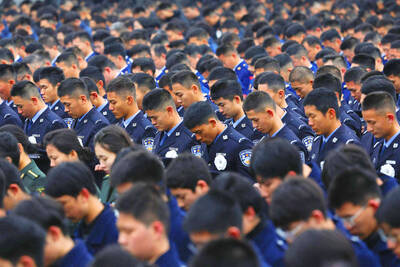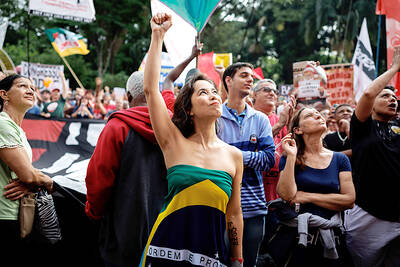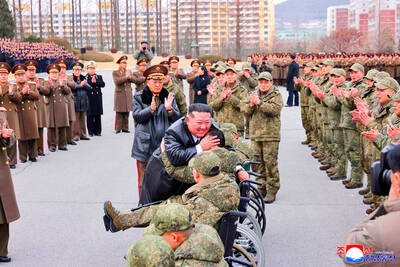A senior Chinese trade official yesterday denied the country’s policies on rare earths constituted cartel-like behavior and insisted shipments of the materials to Japan were never blocked.
Rare earths — a group of 17 elements — are used in high-tech products ranging from flat-screen televisions to lasers to hybrid cars, and China controls more than 95 percent of the global market.
However, Jiang Fan (江帆), vice director-general of the commerce ministry’s foreign trade department, insisted that the companies involved in the trade — not Beijing — were setting the prices.
“They are deciding the price according to the market and the Chinese government cannot control this,” she said during a two-day rare earths industry conference in Xiamen.
The father of China’s economic reforms, Deng Xiaoping (鄧小平), once compared China’s rare earths to the Middle East’s oil, and critics increasingly accuse Beijing of emulating the 12-member OPEC cartel.
China has cut rare earth exports by between 5 percent and 10 percent a year since 2006 as demand and prices soar.
The official China Daily newspaper reported yesterday the country would again cut rare earth export quotas by up to 30 percent next year to protect the metals from over-exploitation, citing an unnamed commerce ministry official.
Jiang said she was not aware of any new export quota decision and Xu Xu (徐旭), the chairman of the China Chamber of Commerce of Metals, Minerals and Chemicals Importers and Exporters called the report “nonsense.”
However, both officials echoed concerns that rare earths reserves could run dry within the next two decades if production remained at current levels.
“Rare earths are not only limited in terms of exports, but also in terms of mining and production — this is for environmental protection and to protect the materials,” Jiang said.
She dismissed suggestions that export cuts were aimed at encouraging foreign firms to move -manufacturing to China.
Jiang also denied Japan’s charge that China’s rare earth shipments to its neighbor stopped last month in a bitter row — the worst in years between the two countries.
“No, never,” she said, laughing when asked about the allegations. “You can see the figures from China customs.”
Japan, however, insists that Beijing is still restricting exports amid ongoing political tensions and said yesterday it was seeking talks on the issue.
“I’ve instructed officials to set up talks with China. Once they’re ready, I want them to get our vice minister in touch with the Chinese counterpart,” Japanese Trade Minister Akihiro Ohata said.

China yesterday held a low-key memorial ceremony for the 1937 Nanjing Massacre, with Chinese President Xi Jinping (習近平) not attending, despite a diplomatic crisis between Beijing and Tokyo over Taiwan. Beijing has raged at Tokyo since Japanese Prime Minister Sanae Takaichi last month said that a hypothetical Chinese attack on Taiwan could trigger a military response from Japan. China and Japan have long sparred over their painful history. China consistently reminds its people of the 1937 Nanjing Massacre, in which it says Japanese troops killed 300,000 people in what was then its capital. A post-World War II Allied tribunal put the death toll

‘NO AMNESTY’: Tens of thousands of people joined the rally against a bill that would slash the former president’s prison term; President Lula has said he would veto the bill Tens of thousands of Brazilians on Sunday demonstrated against a bill that advanced in Congress this week that would reduce the time former president Jair Bolsonaro spends behind bars following his sentence of more than 27 years for attempting a coup. Protests took place in the capital, Brasilia, and in other major cities across the nation, including Sao Paulo, Florianopolis, Salvador and Recife. On Copacabana’s boardwalk in Rio de Janeiro, crowds composed of left-wing voters chanted “No amnesty” and “Out with Hugo Motta,” a reference to the speaker of the lower house, which approved the bill on Wednesday last week. It is

FALLEN: The nine soldiers who were killed while carrying out combat and engineering tasks in Russia were given the title of Hero of the Democratic People’s Republic of Korea North Korean leader Kim Jong-un attended a welcoming ceremony for an army engineering unit that had returned home after carrying out duties in Russia, North Korean state media KCNA reported on Saturday. In a speech carried by KCNA, Kim praised officers and soldiers of the 528th Regiment of Engineers of the Korean People’s Army (KPA) for “heroic” conduct and “mass heroism” in fulfilling orders issued by the ruling Workers’ Party of Korea during a 120-day overseas deployment. Video footage released by North Korea showed uniformed soldiers disembarking from an aircraft, Kim hugging a soldier seated in a wheelchair, and soldiers and officials

Cozy knits, sparkly bobbles and Santa hats were all the canine rage on Sunday, as hundreds of sausage dogs and their owners converged on central London for an annual parade and get-together. The dachshunds’ gathering in London’s Hyde Park came after a previous “Sausage Walk” planned for Halloween had to be postponed, because it had become so popular organizers needed to apply for an events licence. “It was going to be too much fun so they canceled it,” laughed Nicky Bailey, the owner of three sausage dogs: Una and her two 19-week-old puppies Ember and Finnegan, wearing matching red coats and silver